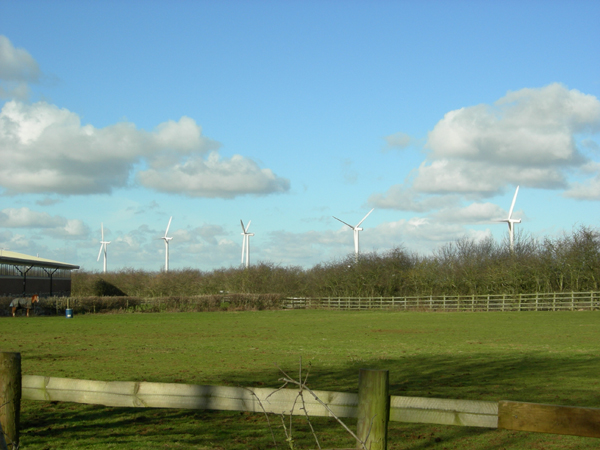
Energy on your farm
Energy generation is important, but don’t forget to take the following approach first:
- Reduce your usage
- Increase your energy efficiency
- Install renewable energy options
Monitoring results wherever possible using meters and ensuring consumption doesn’t go up in one area just because reductions have been made in another area are both important.
A good place to look for energy monitoring equipment is Open Energy Monitor who’s equipment will allow you to track your consumption in Half Hourly increments. This data can then be used to understand how much energy Solar PV or other renewable options could offset.
Renewable energy
Generating renewable energy is a good way to insulate our farms against rising costs. Recent increases in gas prices for example have been due to wholesale price rises on the international market, while ‘home-grown’ renewable energy, such as solar, wind and biomass, face no such pressures. Renewables also help ensure a secure supply of energy.
Since the expiry of the Feed in Tariff there are no government supported options for installing Renewable Energy on your farm, however payback periods of between 5 and 8 years are typical for farms which are able to offset their own energy consumption with Solar PV.
On-farm renewable energy options
Renewable energy can provide power (electricity) for lighting, machinery and appliances and direct heating or cooling for sheds, farm buildings, grain storage and offices. All installations should be carried out by MCS accredited companies (Government approved installers) and the installer’s financial and energy generation projections examined carefully before committing to a project.
We cover farm-use scale projects below, but we as farmers are in a unique position compared to other industries, in our ability to consider large scale projects on our land. Such projects (typically over 2MW in capacity) are technically, financially and legally distinct from smaller scale projects and require detailed, tailored advice.
Renewable energy technologies suitable for an on-farm setting;
Solar Panels – Produce either electricity (from photovoltaic, or PV, panels) or heating for hot water (solar hot water panels). Solar panels convert the Sun’s energy into electricity or heat and work even on cloudy days. Attractive returns are still available despite the end of Government’s Feed-in-Tariffs (FiTs) scheme. However, profitability usually requires that you use a substantial part of the the energy you generate on your own site.
Rooftop solar installations currently cost between £550 and £800 per kWp installed, giving an approximate 20 year lifetime cost per kWh of between 4p-7p/kWh generated. With electricity costs upwards of 15p/kWh and rising solar PV can provide a sensible return on investment. Care should be taken when planning an installation of solar PV that consumption fits with the daily and seasonal cycles. For example ventilation for poultry sheds is well suited (most needed in hottest part of the day/year) whereas lighting for night time activities is not suitable without added battery storage.
Background information on solar power from the Solar Trade Association.
Wind turbines – Provide electricity for on-farm use and for export to the grid. Available in a range of sizes, from large scale (1.5 MW, 120m high), to small scale (5 kW, up to 10m high). Turbines require careful siting and several factors to be taken into consideration, including; wind speed (above at least 5m/s), proximity to the nearest properties, grid access, nearby radar and airport installations, and visual impact. Your local planning department should be consulted early on in the process. When positioned correctly and with the right conditions, wind turbines can generate very attractive financial returns for your business.
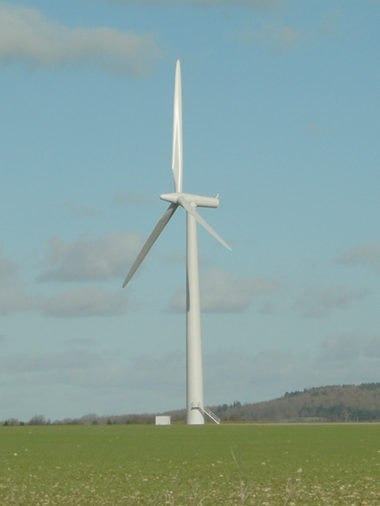
Consider if – You have good wind speeds (National Windspeed Database here) and have a site at least 300m from the nearest home, with no airports or radar sites nearby.
Ground source heat pumps – Generate heat for space and water by using underground pipes to absorb the natural heat of the ground, which stays at a near constant temperature even during winter. Horizontal or vertical trenches must be dug to bury the pipework – some outdoor space near the installation is therefore essential.
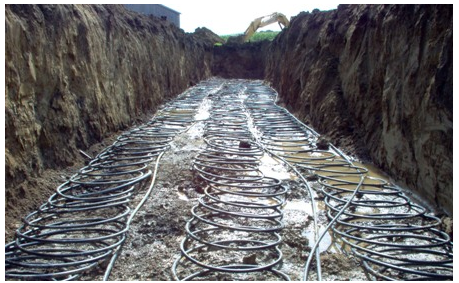
Ground Source Heat Pump cables before burial (Mark Johnson)
Consider if – You have suitable outdoor space for buried pipework
Information on costs, maintenance and more general information is available from the Energy Saving Trust here
Water source heat pumps – Require a body water near to the heat baseload demand – coiled pipework is sunk to the bed of the water body rather than buried underground and the natural heat of the water provides the energy in the same way as with a ground-source heat pump.
Consider if – You have high heating demands and a suitable stream, reservoir or pond which is not regularly drained and located within 50m of the heating baseload. You can accept and work within the uncertainties surrounding future financial incentives.
Air source heat pumps – These are often directly attached to the outside of buildings and therefore do not require the space necessary for ground source heat pumps so are suited to many locations, particularly where space is an issue. They provide heat for a range of uses including direct heat and hot water. They emit a noise roughly equivalent to a dishwasher when running and planning rules are that they should not be sited too near to neighbours.
They work by taking heat from the outside air and can operate in winter temperatures as low as -15°C.
Consider if – You have high heating demands but don’t have the space for a ground source heat pump. You can accept and work within the uncertainties surrounding future financial incentives.
Read the Energy Saving Trust’s guide to air source heat pumps here
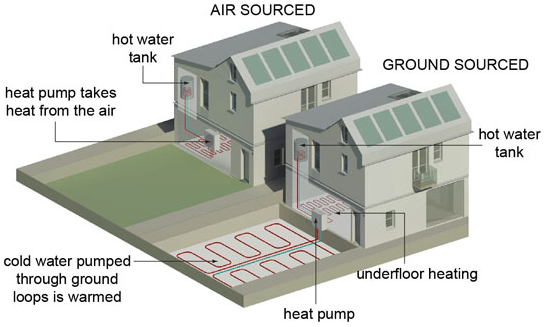
How ground and air source heat pumps work (Source: idea.gov.uk)
Biomass boilers – Generate direct heating for buildings by burning wood (logs, waste and trimmings, or pellets – termed biomass) that could come straight from your farm. They can also be used to heat hot water systems. Especially if replacing electric heaters, biomass boilers offer considerable savings and generate income from the Renewable Heat Incentive . Sufficient storage space near the boiler is required for the biomass itself. Biomass boilers can operate either entirely automatically; requiring only regular refills and maintenance but the largest amount of storage space, semi-automatically; requiring regular manual supply of the boiler, via a gravity fed pellet system which is best for sites with less storage space, or using a Combined Heat and Power plant (see below) using waste wood or offcuts.
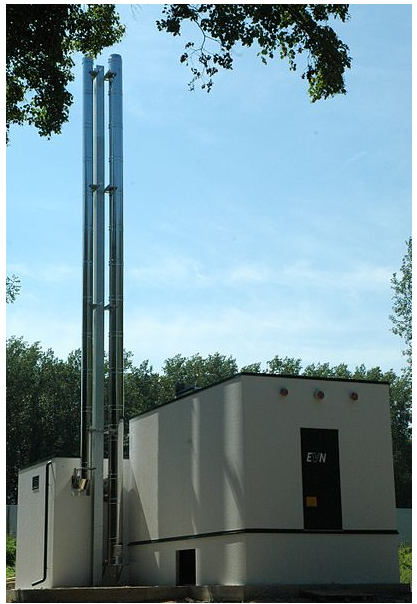
Consider if – You have high heating demands and your current source of heat is electricity or oil
Hydroelectricity – Hydroelectric systems (‘micro-hydro’ or ‘hydro power’) use water flowing through a turbine to run a generator and create electricity. Steeper watercourses and faster flowing channels create more energy. They can be installed in different sized watercourses or ‘retrofitted’ onto some existing weirs. The Environment Agency need to be consulted when considering developing a hydro project, and energy generated is eligible for Feed in Tariff payments just like energy from solar panels and wind turbines.
Consider if – You have a fast running stream or river on your land suitable for a small diversionary channel
More information on hydroelectricity from NFU Energy Farming
Combined Heat and Power (CHP) – CHP units can provide both electricity and heat by utilising fuel usually only used to create either heat or electricity, to create both. They can be fitted in domestic (micro-CHP) or large non-domestic (packaged or mini-CHP) buildings. Packaged and mini systems can be designed to continue providing power to important machinery in the event of a power cut but most require mains gas supplies to operate, although biomass can also be used as a fuel. Large plants can also be designed to provide cooling (‘trigeneration’). The viability of non-domestic mini-CHP depends on the level of consistent demand for the heat and electricity produced, so buildings which only require heating for part of the year or a few hours a day are not suitable. Manufacturing or drying processes would be well suited to a CHP plant as baseload demand is high.
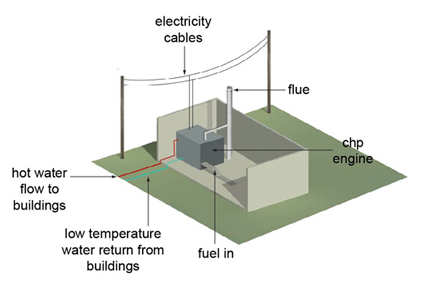
How a CHP plant works (Source: idea.gov.uk)
Consider if – You have a high and consistent demand for heat and power. You want to ensure energy supplies for critical infrastructure in the event of grid power cuts.
Overview of Combined Heat and Power plants from CLASP
Anaerobic digesters – Generate electricity, heat, and a natural fertiliser by-product (‘digestate’) that can replace chemical fertilisers. Anaerobic digestion (AD) plants work by breaking down matter added to them without using oxygen. Feedstock can include manure, arable crops such as maize, food waste, and other sources such as sewage. AD plants generate income and save money in three ways – Feed in Tariffs from the electricity produced, Renewable Heat Incentive from the heat produced, and financial savings from the reduction in chemical fertiliser use. If handling waste sources, ‘gate receipts’ for disposing of this waste may also be generated. Planning must involve the Environment Agency and indicate a clear plan for how the digestate generated will be used. Contact ADBA for more information.
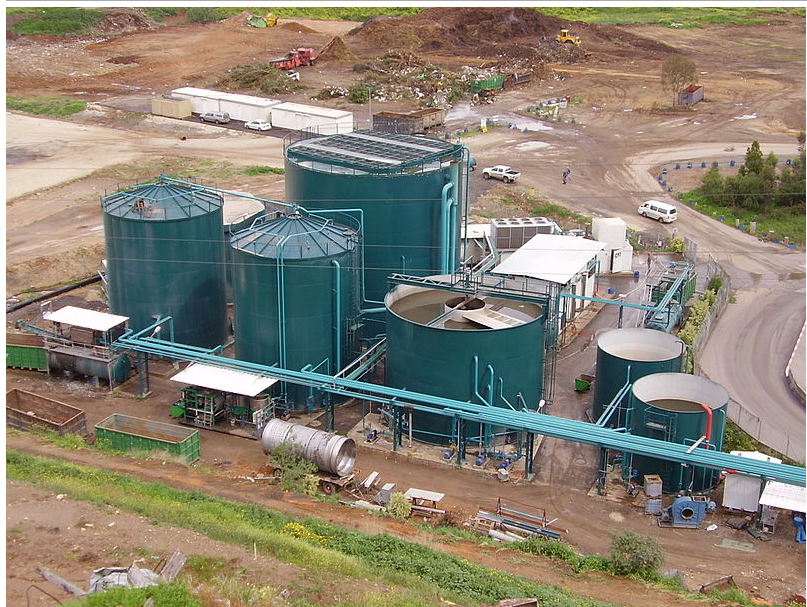
Anaerobic Digestion Plant (Source: Alex Marshall)
Consider if – You have suitable and sufficient feedstock(s) (or can source these). Fertilisers are a major cost for your farm and you can use the digestate produced (or find someone else who can)
More information about on-farm anaerobic digestion from the NFU
More information on renewable energy:
Background information on renewable energy technologies:http://www.greenfacts.org/en/energy-technologies/links/index.htm
Carbon Trust Renewable Energy guide for business:http://www.carbontrust.com/media/7379/ctv010_-_renewable_energy_sources.pdf
Energy Saving Trust guide to renewable energy technologies:http://www.energysavingtrust.org.uk/Generate-your-own-energy
Find an accredited renewable energy installer near you from the MCS scheme:http://www.microgenerationcertification.org/mcs-consumer/installer-search.php

